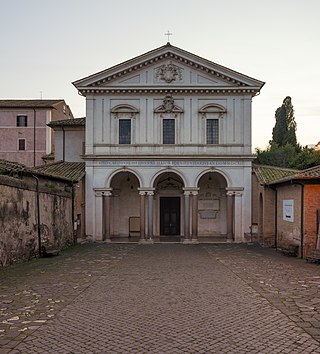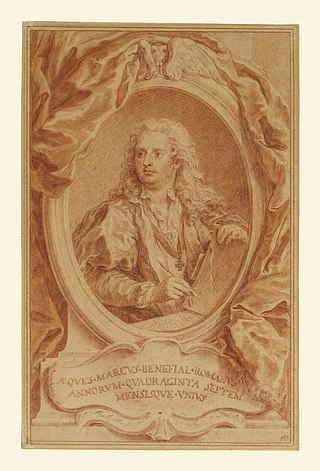
GiacomoBarozzida Vignola, often simply called Vignola, was one of the great Italian architects of 16th century Mannerism. His two great masterpieces are the Villa Farnese at Caprarola and the Jesuits' Church of the Gesù in Rome. The three architects who spread the Italian Renaissance style throughout Western Europe are Vignola, Serlio and Palladio. He is often considered the most important architect in Rome in the Mannerist era.

Campitelli is the 10th rione of Rome, Italy, identified by the initials R. X, and is located in the Municipio I.

The Basilica of Saint Mary of the Altar in Heaven is a titular basilica and conventual church of the Franciscan Convent of Aracoeli located the highest summit of the Capitoline Hill in Rome, Italy. From 1250-1798 it was the headquarters of the General Curia of the Order of Friars Minor as well as being once of the cities principal civic churches. It is still the designated church of the city council of Rome, which uses the ancient title of Senatus Populusque Romanus. The present cardinal priest of the Titulus Sanctae Mariae de Aracoeli is Salvatore De Giorgi.

The Palazzo Venezia or Palazzo Barbo, formerly "'Palace of Saint Mark'", is a large early Renaissance palace in central Rome, Italy, situated to the north of the Capitoline Hill. Today the property of the Republic of Italy it houses the National Museum of the Palazzo Venezia. The main (eastern) facade measures 77 metres (253 ft) in length, with a height of about 31 metres (102 ft). The north wing, containing the "Cibo Apartment", extending westwards, measures 122 metres (400 ft) in length. It covers an area of 1.2 hectares and encloses two gardens and the Basilica of Saint Mark. It was built in the present form during the 1450s by Cardinal Pietro Barbo (1417-1471), titular holder of the Basilica of Saint Mark, who from 1464 ruled as Pope Paul II. Barbo, a Venetian by birth as was customary for cardinals of the Basilica of Saint Mark, lived there even as pope and amassed there a great collection of art and antiquities. During the first half of the 20th century it became the residence and headquarters of the fascist dictator Benito Mussolini, who made notable orations from its balcony to huge crowds filling the Piazza Venezia.

Giacomo della Porta (1532–1602) was an Italian architect and sculptor, who worked on many important buildings in Rome, including St. Peter's Basilica.

There are more than 930 churches in Rome, which makes it the city with the largest number of churches in the world. Almost all of these are Catholic.

San Sebastiano fuori le mura, or San Sebastiano ad Catacumbas, is a minor basilica in Rome, Central Italy. Up to the Great Jubilee of 2000, San Sebastiano was one of the Seven Pilgrim Churches of Rome, and many pilgrims still favour the traditional list.

San Martino ai Monti, officially known as Santi Silvestro e Martino ai Monti, is a minor basilica in Rome, Italy, in the Rione Monti neighbourhood. It is located near the edge of the Parco del Colle Oppio, near the corner of Via Equizia and Viale del Monte Oppio, about five to six blocks south of Santa Maria Maggiore.

Marco Benefial was an Italian, proto-Neoclassical painter, mainly active in Rome. Benefial is best known for his repudiation of 18th century decorative Rococo styles pre-eminent in the Rome dominated by Carlo Maratta pupils. His paintings portrayed tangible human figures, with complex treatment of space, and luminous, warm colors. Along with the altarpieces and frescoes, he also painted many portraits. Because he partnered with some inferior artists who subsequently received credit, some of his paintings have been frequently misidentified.
Giovanni Odazzi was an Italian painter and etcher of the Baroque period, active mainly in Rome.

The Basilica of Saint Anthony of Padua al Laterano is a Roman Catholic titular church in Rome on Via Merulana, one block from the Obelisk of St. John Lateran. It was built for the Order of Friars Minor, who needed a new home after they were moved from Santa Maria in Ara Coeli to allow the construction of the Victor Emmanuel II Monument.

The Chiesa di Santa Rita da Cascia in Campitelli is a deconsecrated church in Rome (Italy), in the rione Sant'Angelo; it is located in Via Montanara, at the crossroad with Via del Teatro Marcello. The church formerly rose on the preexisting church of San Biagio de Mercato, dating at least to the 11th-century. The remains of St Blaise putatively were discovered during the dismantling of Santa Rita.

The Santo Bambino of Aracœli, sometimes known as the Bambino Gesù di Aracœli is a 15th-century Roman Catholic devotional replicated wooden image enshrined in the titular Basilica of Santa Maria in Aracoeli, depicting the Child Jesus swaddled in golden fabric, wearing a crown, and adorned with various gemstones and jewels donated by devotees.
Pietro Peregrosso was a Roman Catholic legal scholar, ecclesiastical bureaucrat, and Cardinal (1288-1295). He had a sister, who was a nun at the convent of S. Agnete de Archagniago at the Porta Vercellina in Milan. He had a nephew, Belviso de Perego, to whom he left a legacy.

Via Alessandrina is an urban street in Rome (Italy), at the southern end of the Rione Monti, passing alongside the ruins of the Imperial Fora.

Decoration for a Thesis in Honor of Saint Francis Solano is an etched print in two sheets by the Italian printmaker Stefano della Bella, made in 1639 as an invitation or advertisement for a debate defending a theological thesis. The event took place in the Franciscan convent of Santa Maria in Aracoeli in Rome and was related to the writings of Friar Buenaventura de Salinas y Córdoba. The thesis was dedicated to the Spanish Franciscan friar, Saint Francis Solano for his works with the indigenous communities in the Peruvian Viceroyalty of Spain.

Palazzetto Venezia is a Renaissance palace situated on one side of Piazza Venezia, in the historic center of Rome, Italy.

The so-called Tower of Paul III was a characteristic fortified villa belonging to the Popes, rising on the Capitoline Hill in Rome (Italy).
The edifice was built in the 16th century by the architect Jacopo Meleghino at the behest of Pope Paul III and demolished in 1886 as part of the construction works of the Vittoriano. Its official name was Palazzo di Aracoeli, but it was also known as Rocca Paolina and Torre Paolina.

The history of the Vittoriano, an Italian national monument complex located in Rome's Piazza Venezia on the northern slope of the Capitoline Hill, began in 1878 when it was decided to erect in the capital a permanent monument named after Victor Emmanuel II of Savoy, the first king of Italy in the modern era, who brought the process of Italian unification to fruition, so much so that he is referred to by historiography as the “Father of the Fatherland.”


















